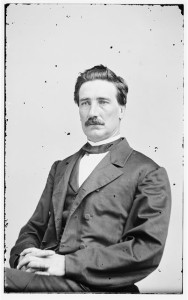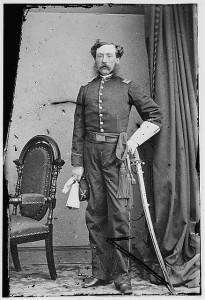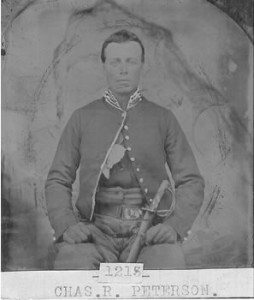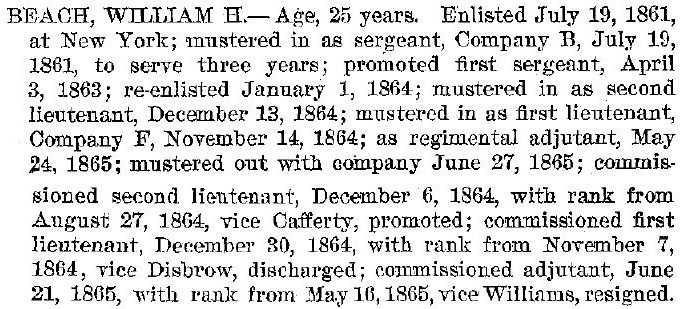In the fall of 1862 the 1st New York Cavalry Regiment operated in northwest Virginia. One of its main jobs was apparently protecting the Baltimore and Ohio Railroad from rebel raiders in the soon-to-be 35th state in the federal Union. Here a cavalryman recounts his regiment’s autumnal adventures for the benefit of his (presumably) hometown paper.
From a Seneca County, New York newspaper in December 1862:
FROM W.H. BEACH.
CAMP of 1st N.Y. CAVALRY,
North Mt. Station, Va., Dec. 17, 1862.
ED. COURIER. – When the army left Maryland after the battle of Antietam, the 4th Cavalry brigade, of which this regiment is a part, with several new infantry regiments, was sent to increase the force for the protection of the Baltimore & Ohio Railroad in Northern Virginia, and to guard against rebel raids in that direction. Our march over the mountains was on the turnpike which at Cumberland becomes the old national road.
The portion of the Mountain Department to which we belonged was under the command of Brig. Gen. Kelley whose headquarters were at Cumberland. Squadrons or battalions of Cavalry were posted at different places among the mountains. The 2nd battalion was stationed at Springfield, an old town mostly of log houses in Hampshire Co.
On our scouts we made ourselves familiar with the valleys of Patterson’s Creek, the South Branch and Great Capon Rivers. – While the Indian Summer days lasted, along these rivers as they rushed swiftly over their rocky beds and under great hanging rocks, or widening, lingered in more peaceful places, the gray, rugged rocks and many-colored woods of the mountains were mingled in scenery of wild and charming beauty. – The arable land lies in the narrow bottoms along the rivers. It is very fertile but there is little of it. The mountains were full of deers, wild turkeys, wild cats, &c., to afford us amusement when rebel hunting would no longer furnish us excitement.
The region through Hampshire and adjoining counties is full of places of deep historical interest. The roads and other land-marks are for the most part still as they were left by Washington, who when a boy, surveyed the tract for Lord Fairfax. Many places were scenes of fierce conflicts with the Indians in the early history of the country. – Great Capon, or Cacahepon Springs, a noted watering place, and Ice Mountain, among whose rocks ice is formed throughout the summer, were places of much attraction in times of peace. There is reason to believe that the Virginian Alleghanies, as well as the same mountains in Maryland and Pennsylvania, are rich in mines of iron ore and coal, though they have been but little developed, notwithstanding the ease of access to eastern cities by the Balt. & O.R.R. It is to be hoped that this war will end the day, when home interests must be sacrificed at the bidding of a single imperious interest.
Our campaign among the mountains was full of exciting adventures. Col. Imboden, a bold rebel chief, long lay in the country about Moorefield, and his scouting parties, at home in the country and possessing perfect knowledge of the roads and trails on the mountains, were often a source of annoyance. They could always find active friends among the rebel citizens. Many of the women were especially relentless in their hatred of the Yankees and their zeal to trouble them.
Lively skirmishes were of frequent occurrence. On one occasion a small reconnoitering party some miles beyond Romney fell in with a party of rebel cavalry, and chased them several miles through a deep narrow gap, when a large body of fresh cavalry turned upon the pursuers. Only three of the Union party had horses fresh enough to bring them safely out of the furious chase of ten miles that succeeded. the captain of Co. B, who commanded the party, was taken prisoner. Of fourteen whose horses failed, all but four escaped by turning aside in the rocks and woods, amid volleys from the pursuing rebels.
Imboden would give his infantry leave to furnish themselves with horses in any way they chose and serve as cavalry. A party of them were long prowling upon the mountains about Springfield attacking our pickets night after night in succession, and ready to capture a wagon whenever one was sent out by day without a guard. In spite of the ceaseless vigilance of the pickets, the constant readiness of a strong reserve, and many well laid plans to entrap them, the horse thieves generally escaped. Occasional brisk skirmishes taught them to avoid us in daylight. A party of four of Co. B, sent on a daring reconnoissance of four days, evading the rebel pickets and scouting parties, found Imboden’s camp. A few days afterwards Gen. Kell[e]y with about a thousand cavalry, a few companies of infantry and a battery of artillery, went out to capture the rebel force. The infantry rode in wagons that they might be fresh for a fight at the end of the march. It was a snowy morning when we started. – All day and all the squally night following, we pressed rapidly forward, over the rocky roads, fording the swift rivers, and through the dark pine woods on the mountain sides, that were darker and gloomier under the weight of damp snow that loaded them down. So [?] after daylight we had driven in the pickets, and were before the rebel stronghold in the deep, narrow valley of the South Fork, eighteen miles from Moorefield and sixty from our starting place. The ground was so chosen that it was impossible to gain the rear or to make an attack on either flank. The cavalry dashed impetuously into the camp, when the frightened rebels fled to the mountain, climbing like cats up among the rocks. The artillery from admirable positions on either side of the valley speedily shelled many of them down, when they fell into the clutches of the cavalry, who stood eagerly waiting to pounce upon them. At every discharge of the cannon the sound echoed and re-echoed from one mountain to the other until it rolled in a continued roar away down the valley. After burning the camp the expedition returned, with many prisoners and large droves of fat cattle and hogs that had been collected by the rebel army.
When the rebels again became particularly troublesome one of Company B, at the request of Gen. Kelley, volunteered to learn their new position. Perfectly disguised, and with a well contrived story of a peaceful farmer living across the Potomac, he rode away. He had partially succeeded in his object when he was arrested, charged with being a spy, robbed of his horse, pocketbook and everything but the clothing he wore, and threatened with immediate hanging. An officer who heard him tell his story and assert his innocence, ordered to be kept under a close guard for a few days when he would attend to him further. He had good reasons to expect hanging if he staid, and therefore thought best to get away. One night he silently escaped out of a window while his guard was asleep, and finally arrived, foot-sore and weary, at his Company’s quarters.
Upon the withdrawal of Jackson with the greater portion of his army from Winchester, we were ordered further east. A two days’ march brought us here by way of Bloomer’s Gap. It was a mild, bright afternoon when we crossed the last ridge of the Alleghanies, and before us lay the broad, laughing valley of the Shenandoah, with its wide, well-fenced farms, fine, large houses, and great barns. It was a pleasant relief to our eyes, whose vision had long been circumscribed by dark, rugged mountains.
The railroad had been destroyed as completely as possible, but is now being rapidly relaid. The rebels had done much other mischief; but there is not in this section that complete desolation that marks the path of a great army. Martinsburg has for some time been free from rebel soldiers, but they are still in some force this side of Winchester.
The day after our arrival here, which was a week ago, a scouting party of twenty-five from Cos. B and M, under Lieut. Prendergast, on the Winchester road beyond Martinsburg came upon a rebel picket, which rallied on a reserve, in all about forty of the 7th Va. cavalry. They were disposed to make a stand; but our men were eager for a fight, and charged upon them so impetuously that they broke and fled. A most exciting chase followed; our men shouting close on the heels of the rebels who were urging their horses to their utmost speed. One after another, losing ground a little, would reel under a sturdy sabre blow from some one who had gained his side, and fall back. After a chase of several miles a halt was ordered for fear we would run into a large force near Bunker’s Hill. One man, mistaking some rebels with Union coats for our men, rode up to them and was taken prisoner, but suffered to go when they had taken his horse, which is one of the finest in the regiment, and we have all learned to feel the warmest friendship for a good horse – a cavalry soldier’s best friend. When we had ceased to follow, the rebels formed across the road. But as our comrade came back crying frantically that the rebels had his horse, the boys, not waiting for an officer, with one accord gave a shout to charge “once more for Casey’s horse!” and the rebels broke and fled again. Another hot pursuit, and we came back with thirteen prisoners and the recaptured horse – the best prize of all.
I believe that if anything akin to the emotion of sublimity is ever experienced in war it is in a bold cavalry charge; and bolder, more successful little dashes than that which our men made do not often occur. Not a man of our party was injured, though at times the rebels fired back continuous volleys. It is reported by citizens along the road that twelve rebels were wounded – four mortally. Several of the prisoners were also dangerously wounded.
Among the most eager of the pursuers was Corporal Peterson, of Canoga, than whom Seneca County has not sent a braver, or truer boy to the wars.
News does not reach us very regularly. We are all looking eagerly toward Richmond. We have many reports, but do not know what ones to believe. Our rough life has many enjoyments, but we are watching anxiously for the coming of the day that shall bring peace to the re-united country.
W.H.B.
You can read Lieutenant Prendergast’s report on the December 11, 1862 Skirmish at Darkesville at the West Virginia Division of Culture and History.
John Daniel Imboden was promoted to brigadier general in January 1863.. He was involved a great deal in various attacks to destroy parts of the Baltimore & Ohio Railroad.
Brigadier General Benjamin Franklin Kelley is mentioned in the story I linked to at Seven Score and Ten – he ordered the firing of a 35 gun salute from a captured cannon on news that West Virginia would be admitted to the Union.
Members of 1st NY Cavalry in our story.

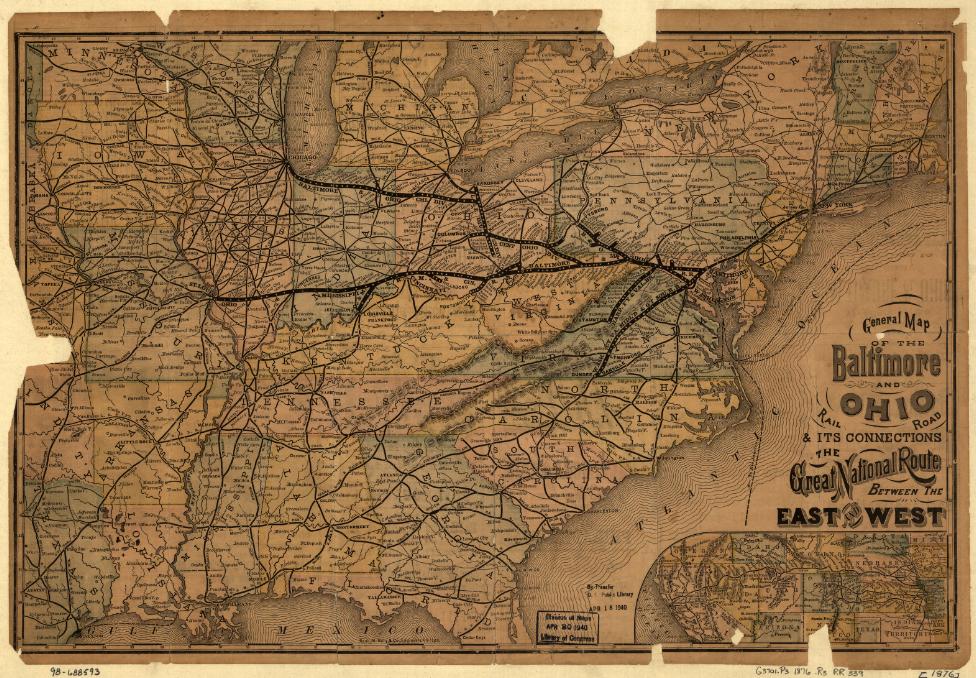
![Gen. [B. F. ?] Kelly (between 1855 and 1865; LOC: LC-DIG-cwpbh-01158)](https://www.bluegrayreview.com/wp-content/uploads/2012/12/01158r-192x300.jpg)
